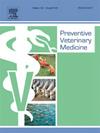利用农场风险评估数据管理北爱尔兰奶牛约翰氏病
IF 2.2
2区 农林科学
Q1 VETERINARY SCIENCES
引用次数: 0
摘要
约翰氏病(JD)在临床感染的牛中引起体重减轻、腹泻和产奶量减少。2020年,北爱尔兰动物卫生和福利(AHWNI)启动了一项自愿JD控制计划(JDCP),重点是生物排斥、生物控制和市场保证。授权兽医从业人员(avp)执行兽医风险评估和管理计划(VRAMP),并使用该信息提出最多三条建议。在2022年8月至2024年1月期间,2274头牧群参加了NI JDCP,并进行了多达三次vramp。本研究描述了与JD相关的风险和兽医建议,确定了与JD确诊病例相关的风险,并评估了农民是否根据AVP的建议改变了他们的做法。avp为管理实践分配风险分数。与产犊区有关的做法,特别是没有或延迟抓拍产犊,显示出最高的平均风险评分。专题分析强调了AVP建议中的五个主要主题,包括诊断测试的使用和产犊区管理。多变量二项逻辑回归确定了五种显著增加牛群确诊JD病例可能性的管理措施,包括将临床感染或检测阳性的奶牛与产犊区的其他牛群隔离开来。对进行第一次和第二次vramp的278个畜群的风险评分和对封闭问题的回答进行分析表明,农民没有根据AVP的建议改变他们与jd相关的管理实践。这些发现同时概述了JD控制中的挑战,加强了vramp在识别JD相关风险中的使用,展示了AVP建议主题的一致性,并提供了行业和政策制定者可以考虑的数据。本文章由计算机程序翻译,如有差异,请以英文原文为准。
Utilising on-farm risk assessment data for the management of Johne’s disease in dairy cattle in Northern Ireland
Johne’s disease (JD) causes weight loss, diarrhoea, and reduced milk yields in clinically infected cattle. In 2020, Animal Health and Welfare Northern Ireland (AHWNI) launched a voluntary JD control programme (JDCP) which focuses on bio-exclusion, biocontainment and market reassurance. Authorised veterinary practitioners (AVPs) conduct a Veterinary Risk Assessment and Management Plan (VRAMP) and use this information to make up to three recommendations. Between August 2022 and January 2024, 2274 herds enrolled in the NI JDCP and conducted up to three VRAMPs. This study characterised the JD-related risks and veterinary recommendations, identified the risks related to confirmed cases of JD and assessed if farmers changed their practices in response to AVP recommendations. AVPs assigned risk scores to management practices. Practices related to the calving area, particularly an absence of or delayed snatch calving, demonstrated the highest average risk score. Thematic analysis highlighted five main themes within AVP recommendations, including the use of diagnostic testing and management of calving areas. Multivariable binomial logistic regression identified five management practices which significantly increased the likelihood of herds having had a confirmed case of JD, including the segregation of clinically infected or test-positive cows from the rest of the herd in the calving area. Analysis of the risk scores and responses to closed questions from 278 herds which conducted first and second VRAMPs suggested that farmers had not changed their JD-related management practices in response to AVP recommendations. These findings simultaneously outline the challenges in JD control, reinforce the use of VRAMPs in identifying JD-related risks, demonstrate the harmonisation in AVP recommendation themes and provide data which can be considered by industry and policy makers.
求助全文
通过发布文献求助,成功后即可免费获取论文全文。
去求助
来源期刊

Preventive veterinary medicine
农林科学-兽医学
CiteScore
5.60
自引率
7.70%
发文量
184
审稿时长
3 months
期刊介绍:
Preventive Veterinary Medicine is one of the leading international resources for scientific reports on animal health programs and preventive veterinary medicine. The journal follows the guidelines for standardizing and strengthening the reporting of biomedical research which are available from the CONSORT, MOOSE, PRISMA, REFLECT, STARD, and STROBE statements. The journal focuses on:
Epidemiology of health events relevant to domestic and wild animals;
Economic impacts of epidemic and endemic animal and zoonotic diseases;
Latest methods and approaches in veterinary epidemiology;
Disease and infection control or eradication measures;
The "One Health" concept and the relationships between veterinary medicine, human health, animal-production systems, and the environment;
Development of new techniques in surveillance systems and diagnosis;
Evaluation and control of diseases in animal populations.
 求助内容:
求助内容: 应助结果提醒方式:
应助结果提醒方式:


